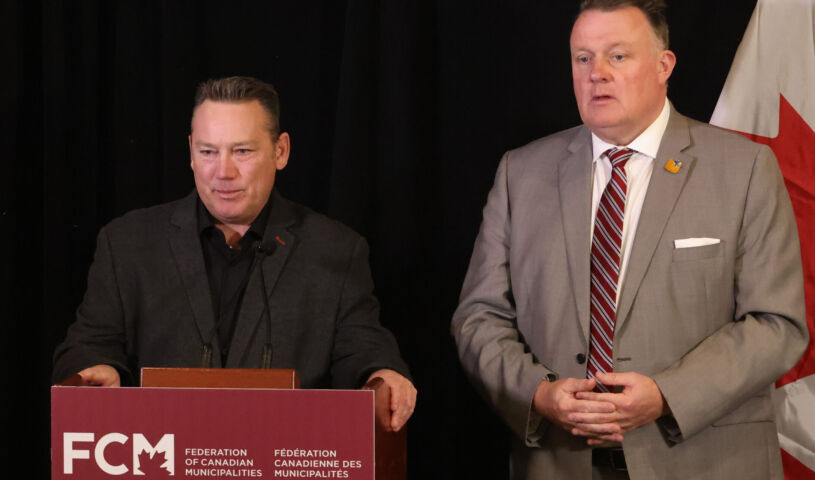FCM’s fiscal relief could build homes, reduce political stress
 Mayors across Canada are calling on Ottawa for urgent investment in infrastructure. FCM President Scott Pearce (left) and Big City Mayors’ Caucus Chair Mike Savage (right) recently discussed the impacts of insufficient funding of local governments by their federal and provincial counterparts. Photo: FCM
Mayors across Canada are calling on Ottawa for urgent investment in infrastructure. FCM President Scott Pearce (left) and Big City Mayors’ Caucus Chair Mike Savage (right) recently discussed the impacts of insufficient funding of local governments by their federal and provincial counterparts. Photo: FCM
He may have been half-joking when he said it, but Scott Pearce was also making a point when he told a group of journalists that he doesn’t know any mayor who wakes up in the morning saying they can’t wait to raise taxes.
Pearce, the mayor of the Township of Gore, Que., was speaking during a media conference in his role as president of Federation of Canadian Municipalities (FCM). Pearce’s comments came last month as mayors of some of Canada’s biggest cities met with officials in Ottawa around FCM’s call to strengthen municipal infrastructure investments ahead of the 2024 federal budget.
FCM’s Big City Mayors’ Caucus gathered to reiterate their call for a stronger, long-term municipal funding partnership with their federal and provincial counterparts.
“We were promised infrastructure funding, and to this day we have not heard of a plan,” Pearce said. “Every unit is costing the municipality $100,000. It’s untenable. But if you want the housing, you have to have the infrastructure. And it’s concerning to all of us that we have yet to hear of a plan and the budget’s coming closer every day.”
Missing Puzzle Piece
Joining Pearce for the media conference was Halifax Mayor Mike Savage. Savage is also chair of the Big City Mayors’ Caucus.
Savage said the missing piece of the puzzle to solve the housing crisis is the essential, sometimes invisible, need of municipal infrastructure. New housing depends on it and it’s essential to building more homes.
FCM is pushing for Ottawa to invest in critical infrastructure. The call comes as the country faces historic crises in housing, affordability, homelessness, and climate change.
Savage repeated that the scale of that challenge is clear, and the housing crisis is not something any single order of government can solve. He was quick to add the same is true for tackling the infrastructure funding gap facing all municipalities.
“Municipalities across the country have been accelerating housing construction, fast-tracking permit approvals, and coming up with innovative zoning solutions to get more housing built faster,” Savage said. “It is high time to empower municipalities with the tools they need to support growth.”
Ottawa’s Infrastructure Pledge
This renewed push from FCM stems – at least in some part – from a pledge made by Prime Minister Justin Trudeau last spring. While addressing delegates at FCM’s annual conference, Trudeau suggested a new infrastructure deal was on the horizon.
But the 2023 budget came and went without an announcement. So too did Ottawa’s fall economic statement. As such, FCM is expressing concern about where that promise of support has gone.
“With the federal government’s promised infrastructure program seemingly stalled, it’s time to look for long-term solutions and close this gap,” Savage said. “We believe it’s time to start to equip communities with adequate, predictable, diverse, and equitable sources of revenue that can support the quality of life that Canadians rightfully expect and deserve.”
In later comments, Peace said the delay is “a bit demoralizing.” He also said it leaves municipalities six months behind. Pearce also said added that FCM isn’t hearing of much movement to date.
The reality is, he explained, municipalities are being called upon to facilitate the construction of 5.8 million houses. But when infrastructure costs are $107,000 per unit, and the municipality may collect $5,000 in property taxes, it creates a significant deficit.
“That’s just a recipe for total failure. It’s not going to happen,” Pearce said. “The federal government has all the money, the provinces have all the power, and the municipalities have all the problems.”
Funding Deficit Builds Stress
The lack of sufficient funding is impacting local infrastructure needs. It is also impacting housing, homelessness, and the fight against climate change. But the absence of adequate funding might also be contributing to another growing problem in the municipal space.
In recent months, France Bélisle, the mayor of Gatineau, Que., and Isabelle Lessard, the mayor of Chapais, Que., both resigned their positions, citing the stresses of working in local government today.
These high-profile cases may well have driven Quebec to recently commit $2 million to connect politicians and their families with psychological aid. The announcement came after a wave of resignations and leaves of absence among elected municipal officials. In fact, almost 10 per cent of politicians have quit since the 2021 municipal elections.
“I do believe the lack of sustainable funding does create yet another pressure on mayors and councillors, which was alluded to in the question around the recent resignations in Quebec,” Savage would later comment. “I was hoping to ask to comment further on this. Yes, the infrastructure question is key, but I am hoping to put further attention on what is driving some people out of the municipal sector.”
Political Pressures, Fiscal Concerns
For his part, Pearce said he has been mayor in Gore for 20 years and he’s never seen this many people resign. Pearce puts that number at around 800 municipal officials in Quebec alone.
The pressures faced by politicians are enormous, Pearce said. It is why FCM makes it a point of working on behalf of all of municipalities. He speculates stable funding would provide “a bit of relief” for elected officials.
But as has been said many times, local government is the government of proximity. And as such, when it comes to something like a lack of housing, frustration is going to be directed at the most accessible target. In the case of Quebec, Pearce said, the personal confrontations at the grocery store aren’t with the Prime Minister or Quebec Premier François Legault. Instead, they are targeted at local officials.
“It’s tough on folks right now, but for the ones that resign, it’s sad,” Pearce said. “For those of us who stayed, it shows the courage and the commitment they have to make their communities better.”
Benefits of New Fiscal Model
While commenting on Pearce’s point, Savage reiterated that local governments own approximately 60 per cent of infrastructure. However, they have seen their responsibilities increase dramatically over the past decade. And yet, they continue operating on eight to 10 cents of every tax dollar collected.
The massive responsibility and funding challenge this has created is leading local officials to make tough decisions with a considerable impact on affordability and the delivery of services.
Savage agreed with Pearce that being the government of proximity means mayors and councillors are too often becoming targets. Savage said the harassment of elected officials has become “alarmingly high,” which has an impact on everyone. But, he added, the level of harassment seems particularly high on women.
“We can’t continue like this if we want to achieve a meaningful and diverse representation of society in local decision making,” Savage said. “That is why it is so important that all orders of government come together to develop and agree on a Municipal Growth Framework. To give municipalities better tools to foster a greater quality of life in every community and higher levels of satisfaction with local leaders.” MW
✯ Municipal World Executive and Essentials Plus Members: You might also be interested in Meyer’s article: National strategy invests in municipal resiliency.
Sean Meyer is Digital Content Editor for Municipal World.
Related resource materials:



